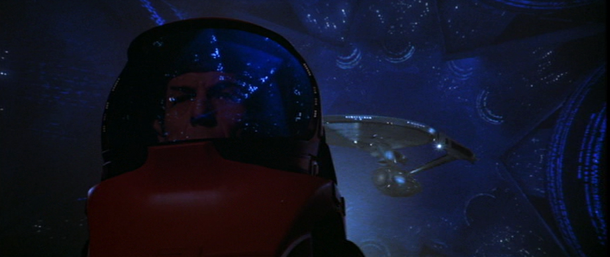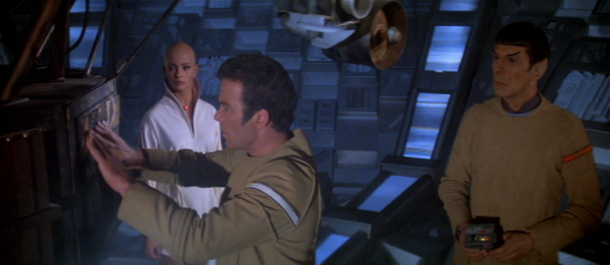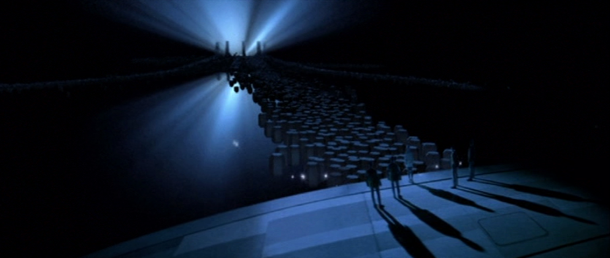Isnt It About Time You Gave Star Trek The Motion Picture Another Chance?
None
It was a huge box office success and relaunched a franchise. So why does everyone remember it as cinematic mogadon, wonders Jayne Nelson?

Case for the prosecution: Picture this, your Honour. It’s 1979. You’re a die-hard Trekkie awaiting the release of the astonishingly expensive, much-hyped Star Trek: The Motion Picture . You haven’t seen a new episode of Star Trek since the series was cancelled in 1969; that’s ten whole years without Kirk, Spock and the Enterprise (let’s forget about the animated series for the sake of our argument). Meanwhile, a little film named Star Wars has been kicking arse around the world: action-packed, fun, rollicking good entertainment, it’s everything you’d love to see in a new Star Trek movie. And seeing as the Trek film wouldn’t have been greenlit without the success of George Lucas’s space opera, you’re pretty sure it’s going to follow the same formula.
So you settle your tingly little bottom on a seat in your local fleapit and prepare to bask in the return of the Federation’s most intrepid heroes… and what you get is a 132-minute, slow-burning, actionless melodrama from a group of bored-looking actors dressed in dull neutral tones who have about as much life in them as the plate of kippers you had for breakfast.
FAIL.
Case for the defence: The scenario my esteemed colleague presents to the court may be true in their experience – in fact, it may be true in the experience of many Star Trek fans. I will accept without question the fact that Star Trek: The Motion Picture might not have been the rip-roaring film many were expecting at the time, but it’s still a mighty fine sci-fi movie and remains so to this day, and should be praised for having an ambition bigger than just being a Star Wars rip-off.
Case for the prosecution: We respectfully disagree, your Honour. Star Trek II: The Wrath Of Khan is a mighty fine sci-fi movie, and that’s because they made a film the polar opposite of everything The Motion Picture was. It wasn’t dubbed “The Motionless Picture” for nothing! The movie’s over two hours long and nothing much happens until the end, and even that’s an anti-climax. It’s a wasted opportunity; pompous, self-important navel-gazing at its worst.
Case for the defence: Rubbish! Lots of stuff happens! For anyone who hasn’t seen the film, it features the USS Enterprise heading out on a mission to contact a mysterious, monstrous “entity” called V’ger which is threatening the galaxy. All sorts of shenanigans later, we discover that V’ger is actually a Voyager space probe which became sentient and decided to come home and wipe out Earth. So the crux of the film is actually a rather cool twist, but while we’re figuring that out we get to see a brand-new Enterprise (the upgrade from the TV show model to the movie model is wonderful), beautiful FX work, a grisly transporter accident, a growing love story between Willard Decker’s chisel-jawed new Commander and bald-headed siren Lieutenant Ilia, an interesting slo-mo battle scene and a truly transcendent finale in which Decker and Ilia merge with V’ger so it understands what life and love is all about.
Weekly digests, tales from the communities you love, and more
In other words, it’s quintessential sci-fi using big themes, just like the original show!
Case for the prosecution: That’s the problem, though – there’s enough material here for an episode of Star Trek , not a full-length movie. To fill all the extra time we get sweeping Enterprise fly-pasts, endless shots of space and an epic and, frankly, boring sequence with Spock voyaging into the heart of V’ger (ripped off from the “stargate” sequence in 2001: A Space Odyssey if you ask us).
And as for the love story… well, the tagline for the film is “The human adventure is just beginning” and yet the crew are like robots, carrying out their work without an ounce of emotion (McCoy’s occasional grumbles aside). Where’s the camaraderie of the show, with all its snarky banter and quipping? Do these miserable-faced crewmembers even know each other? And the love story between Decker and Ilia is superfluous given that we barely know them. Plus don’t even get us started on the fact that Ilia is a woman who gives off some kind of alien sex pheromone that makes men fall madly in love with her. What a load of sexist, male wish-fulfillment tosh!
Case for the defence: We’re with you on that, although for all its alleged championing of feminism in the ’60s we have to point out that the original TV show treated women like sex objects, too, so it’s not just the fault of this film!
With regard to the cast seeming to have no personalities, that’s probably because in the wake of such FX-stuffed hits as 2001 and Star Wars , the filmmakers decided to give the special effects more prominence than the actors – possibly not the best idea in retrospect, but hey, Hollywood’s about making money, isn’t it? They stick with what works to make the big bucks. And, lest we forget, Star Trek: The Motion Picture did make big money. Until First Contact it was the biggest grossing Trek film world wide, and taking into account inflation and increased ticket prices, it was probably the most profitable until JJ Abrams’s Trek reboot in 2009.

Case for the prosecution: Yes, but it’s not just the lack of spark in the acting or dialogue. How about the new Starfleet uniforms worn by the crew? From the rainbow of colours on the film’s poster you’d expect a bright array of costumes, but they’re so bland! It’s as though somebody banned primary colours and dressed everybody using Chairman Mao’s Big Book Of Beige Style. So uninspiring!
Case for the defence: Given that the ’60s were all about colour and psychedelia, chances were that the costumers decided nobody would take Star Trek: The Motion Picture seriously in the slightly less-exotic ’70s if everybody wore lurid, Day-Glo outfits. This was an attempt to get us to take the crew seriously. And that neatly matched the serious script, too.
Case for the prosecution: Your Honour, the defence has just put their finger on the most fundamental issue troubling the film – why make everything more serious if Star Trek ’s original appeal came from its whimsical, tongue-in-cheek approach to exploring the galaxy? Or to put it more simply: WHY SO SERIOUS?
Case for the defence: You can’t blame them for trying to make the world of Star Trek more adult though, surely? Why shouldn’t the film be taken seriously? It’s something many of the spin-off shows tried later on – The Next Generation showing Captain Picard being tortured by the Cardassians, for example – and it worked very well.
Don’t forget, this was a shiny new relaunch off the back of a TV series that was scheduled for the tail-end of the ’70s that never happened. The bean-counters didn’t want to throw all their money at something as camp as Galaxy Quest ; they wanted something with substance that would leave a legacy for future films.
Case for the prosecution: But alas, the only substantial legacies this miserable voyage bequeathed to us was a great score that was later reused as the theme for The Next Generation ; the new-look Enterprise (we agree, it’s great); and bumpy Klingon foreheads, which made their debut here for no reason we can determine.
Other than that, Star Trek: The Motion Picture was an overlong, criminally bland slog that was so busy trying to uphold the philosophies behind Gene Roddenberry’s creation that it forgot to entertain the audience.
M’lud, the prosecution rests its case.
Case for the defence: But… but… it’s so pretty. Surely you agree the film is pretty? All those V’ger effects? There’s a genuine sense of grandeur and awe…
Case for the prosecution: Zzzzzzzzzzz…


Dave is a TV and film journalist who specializes in the science fiction and fantasy genres. He's written books about film posters and post-apocalypses, alongside writing for SFX Magazine for many years.


